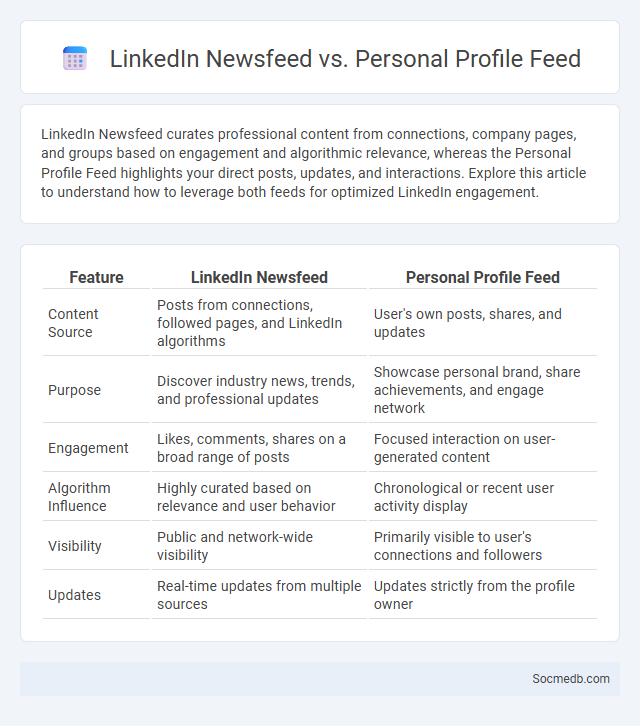
Photo illustration: LinkedIn Newsfeed vs Personal Profile Feed
LinkedIn Newsfeed curates professional content from connections, company pages, and groups based on engagement and algorithmic relevance, whereas the Personal Profile Feed highlights your direct posts, updates, and interactions. Explore this article to understand how to leverage both feeds for optimized LinkedIn engagement.
Table of Comparison
| Feature | LinkedIn Newsfeed | Personal Profile Feed |
|---|---|---|
| Content Source | Posts from connections, followed pages, and LinkedIn algorithms | User's own posts, shares, and updates |
| Purpose | Discover industry news, trends, and professional updates | Showcase personal brand, share achievements, and engage network |
| Engagement | Likes, comments, shares on a broad range of posts | Focused interaction on user-generated content |
| Algorithm Influence | Highly curated based on relevance and user behavior | Chronological or recent user activity display |
| Visibility | Public and network-wide visibility | Primarily visible to user's connections and followers |
| Updates | Real-time updates from multiple sources | Updates strictly from the profile owner |
Introduction to LinkedIn Newsfeed, Personal Profile Feed, and Newsfeed
LinkedIn's Newsfeed serves as a dynamic hub where users engage with content tailored to their professional interests, showcasing updates from connections, industry news, and personalized insights. The Personal Profile Feed highlights an individual's activity, including posts, shares, and interactions, creating a narrative of their professional journey and expertise. This segmented approach to the Newsfeed enhances networking opportunities by delivering relevant, real-time information that drives user engagement and professional growth.
Understanding the LinkedIn Newsfeed
The LinkedIn Newsfeed curates personalized content based on user interactions, industry trends, and professional connections, enhancing networking opportunities and knowledge sharing. Algorithms prioritize posts with high engagement, relevance to a user's field, and timely updates from connections and followed pages. Leveraging insights from LinkedIn Analytics can help optimize content visibility and drive meaningful professional engagement.
Features of the Personal Profile Feed
The personal profile feed on social media platforms displays a curated timeline of user-generated content including posts, photos, and videos, prioritizing recent activity and interactions. Features such as customizable privacy settings, story highlights, and pinned posts enable users to control visibility and showcase important updates effectively. Integration of interactive elements like reactions, comments, and share buttons promotes engagement and community building within the feed.
What is the General Newsfeed?
The General Newsfeed on social media platforms aggregates diverse content such as posts, updates, photos, and videos from your friends, followed pages, and groups. It uses algorithms to prioritize and display the most relevant and engaging information based on your interactions, interests, and preferences. Your General Newsfeed serves as a dynamic stream, keeping you informed and connected with real-time trends and personal connections.
Key Differences Between LinkedIn Newsfeed and Personal Profile Feed
The LinkedIn Newsfeed delivers a curated mix of industry updates, professional articles, and content from your connections to keep you informed and engaged in your network. Your Personal Profile Feed, on the other hand, centers around your own posts, showcasing your achievements, thoughts, and activities to build your professional brand. Understanding these key differences helps you strategically manage content visibility and optimize your LinkedIn experience.
Content Visibility: LinkedIn Newsfeed vs. Personal Profile Feed
Content visibility on LinkedIn varies significantly between the Newsfeed and Personal Profile feed, with the Newsfeed offering broader reach due to algorithm-driven distribution prioritizing engagement and relevance. Your posts in the Personal Profile feed primarily reach direct connections and followers, limiting exposure compared to the Newsfeed's curated content from a wider network. Optimizing content for the LinkedIn Newsfeed by focusing on keywords, hashtags, and timely engagement increases the chances of attracting a larger, targeted professional audience.
Engagement and Reach: How Each Feed Performs
Social media engagement measures interactions such as likes, comments, and shares, directly influencing the reach of each feed by boosting content visibility in algorithms. Higher engagement levels often lead to increased organic reach, allowing posts to appear more frequently in followers' feeds and attract new audiences. Understanding platform-specific metrics and optimizing content for user interaction enhances overall performance across different social media feeds.
Best Practices for Posting on Each Feed
Tailoring content to the unique algorithms and audience preferences of each social media platform enhances engagement and reach. On Instagram, use high-quality visuals and relevant hashtags to increase discoverability, while Facebook favors longer captions and interactive posts like polls or events. Twitter thrives on concise, timely updates and trending hashtags, whereas LinkedIn benefits from professional insights and industry-specific articles to foster networking opportunities.
When to Use Each Feed for Maximum Impact
Utilize Instagram Stories for real-time engagement and behind-the-scenes content to create authentic connections with your audience. Reserve Facebook News Feed posts for detailed updates, promotions, and community interaction where longer captions and links perform well. Use Twitter feeds to share timely news, quick opinions, and trending hashtags that capitalize on rapid information dissemination and hashtag-driven visibility.
Conclusion: Choosing the Right Feed for Your Content Strategy
Selecting the right social media feed is crucial for maximizing engagement and reach within your target audience. Tailoring content to platform-specific algorithms and user behaviors enhances visibility and drives meaningful interactions. Consistently analyzing performance metrics ensures alignment between your content strategy and evolving audience preferences.
 socmedb.com
socmedb.com